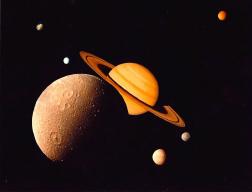

|
Astronomy 161:
An Introduction to Solar System Astronomy
Prof. Richard Pogge, MTWThF 9:30
|
Lecture 40:
The Saturn System

[Saturn System - Voyager 2 image montage, NASA/JPL]
Key Ideas:
Saturn has Bright Rings and 60 known moons
- 1 Giant Moon: Titan
- 59 Smaller Moons, mostly icy
- Those larger than 300km in diameter are round
Enceladus
- Young surface with water-ice fountains
Titan
- Thick Nitrogen & Methane atmosphere
- Lakes of liquid Methane
Rings of Saturn
- Orbiting chunks of ice & rock
The Moons of Saturn
To date, 60 moons have been found orbiting Saturn
59 smaller moons:
- Range in size from 2 to ~1500 km in diameter.
- Moons larger than 300 km in diameter are spherical.
- Moons smaller than 300 km in size are irregularly shaped.
The composition of the smaller moons is mostly ices:
- Mostly icy, or mixes of rock & ice, with mean
densities of 0.3 g/cc to 1.5 g/cc.
All are heavily cratered, but Enceladus stands out for also having
very young terrain.
I've chosen two moons for closer scrutiny here: Enceladus and Titan.
For the current census of the Saturnian Moon System, see Scott
Sheppard's Saturn
Satellite Page.
Enceladus
Enceladus has the brightest (shiniest) surface of any body
the solar system.
- Surface is covered with a layer of fresh, clean ice
The fresh ice comes from the interior of Enceladus, fed by water-vapor
fountains spraying out of cracks in the surface.
- Makes for a thin atmosphere of water vapor with traces
of Carbon Dioxide (CO2), Nitrogen (N2),
and Methane (CH4).
- Repaves the surface with fresh ices
Cryovolcanism
The water fountains on Enceladus are an
example of Cryovolcanism, or ice volcanos.
- One of only 3 geologically active moons (others are Io and Triton).
Source of heat for the cryovolcanism on Enceladus is Tidal Heating
- Enceladus is in a 2:1 orbital resonance with the large moon Dione
(Enceladus completes 2 orbits for every 1 orbit of Dione).
- Heat melts subsurface water, which geysers out through cracks in the surface ice.
Ices from the fountains of Enceladus are responsible for building up
the faint E-ring around Saturn.
Titan
Saturn's only giant moon:
- Radius: 2575 km (2nd largest after Ganymede)
- Mean Density: ~1.9 g/cc
- Icy mantle over a rocky core.
Titan has a heavy atmosphere:
- Only Solar System moon with a heavy atmosphere.
- Cold enough to retain a heavy atmosphere despite it smaller size
Titan's Atmosphere
Composition:
- ~80% N2 (nitrogen)
- ~3% CH4 (methane)
- Mix of argon and hydrocarbons like Ethane
Cold, dense atmosphere:
- Temperature: 94 K (-290° F)
- Surface pressure: ~1.6 Earth atmospheres.
- Clouds of methane & N2 ices
- High layer of hydrocarbon "smog"
Hazy clouds of methane, nitrogen, & suspended aerosols hide the
surface at visible wavelengths.
Methane is Titan's water
Methane appears to play the same role on Titan that water does on the
Earth:
- 94 K is between between the boiling & freezing points
of Methane
- Get gaseous methane in atmosphere.
High pressures allows Methane to condense into clouds that could
rain liquid methane?
- Images of the surface reveal drainage flow channels
- The Huygens probe seems to have landed in a mud of methane and water ice.
The most spectactular evidence is the recent (early 2006) discovery
of lakes on Titan revealed by the Cassini radar mapping experiment.
These could be lakes of liquid methane.
The Surface of Titan
Mostly covered by clouds, but we can peer through at infrared
wavelengths and with radar:
- Cassini imaging, plus Huygens probe descent imaging
and radar imaging.
Young surface with few impact craters.
Varied terrain:
- Smooth, dark plains (methane mud flats or liquid methane seas?)
- Rugged highlands
- Drainage channels (methane rivers?)
- A few large impact basins (e.g. Circus Maximus)
Cassini will make many passes by Titan during its multi-year mission,
using a combination of visible and IR cameras and radar imaging. Over
the next few years, a more complete picture of this strange world should
begin to appear from behind its clouds.
The Rings of Saturn
Saturn's rings are not solid, but instead are composed of
billions of tiny chunks of ice and rock:
- Chunks orbit independently around Saturn like tiny ice
moons.
- Vary in size from a few centimeters up to many meters
across.
- All packed close together, continually colliding, giving
them worn, irregular shapes.
- Shiny ices make the rings appear very bright.
We will study planetary rings in more detail in a separate lecture.
Supplement: Cassini & Huygens
Cassini spacecraft was launched in Oct 1997 on ambitious mission
to orbit and study Saturn, its rings, and its moons, specifically the
moon Titan:
- Went into orbit around Saturn in July 2004.
- Baseline mission is 4-year study through late-2008
Huygens Titan probe (January 2005):
- Carried by Cassini to Titan, and descended in January 2005.
- 2+ hour descent by parachute through Titan's
atmosphere, imaging and analyzing the composition on the
way down.
- Landed on Titan's surface, returning pictures &
chemical analysis of the surface before losing contact.
The Cassini/Huygens mission is a joint US/European effort. Cassini
was built by NASA (JPL), and Huygens by ESA (European Space Agency). You
can learn more about Cassini at the Cassini-Huygens Mission to Saturn
& Titan
web page at JPL. Information on
the Huygens probe is on the Huygens page at ESA.
Readings in Universe:
Chapter 14 sections on Saturn, and Chapter 15-8 and 15-10
Return to [
Unit 6 Index
|
Astronomy 161 Main Page
]
Updated: 2006 November 19
Copyright © Richard W. Pogge,
All Rights Reserved.
